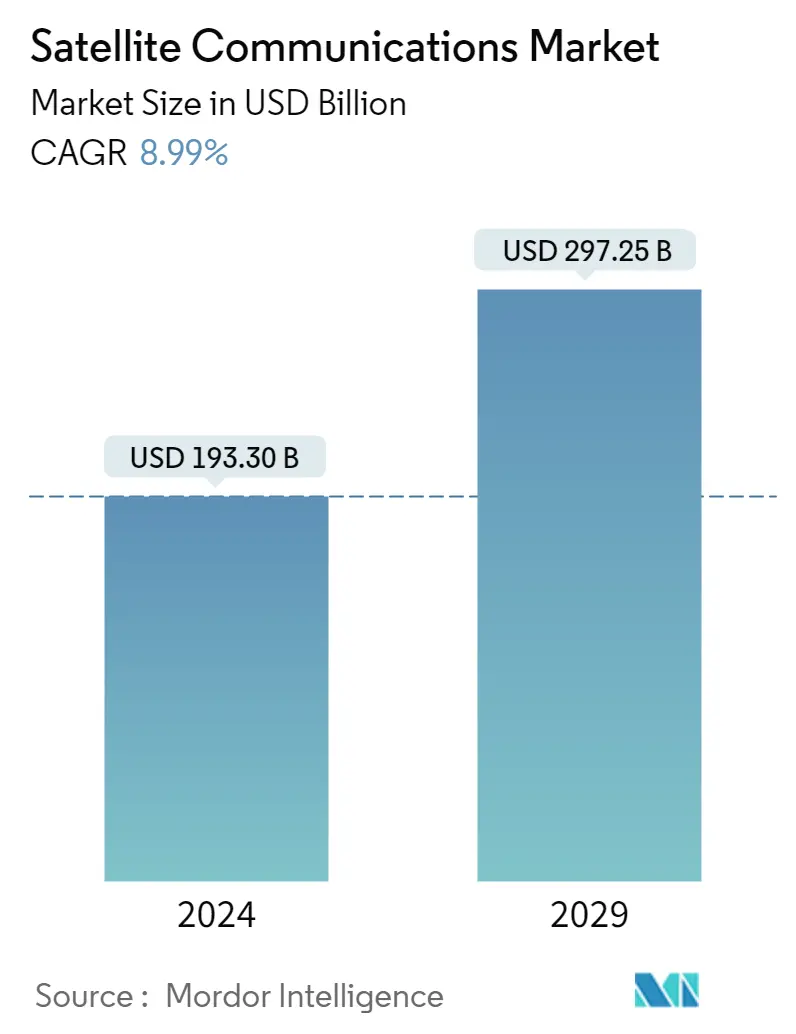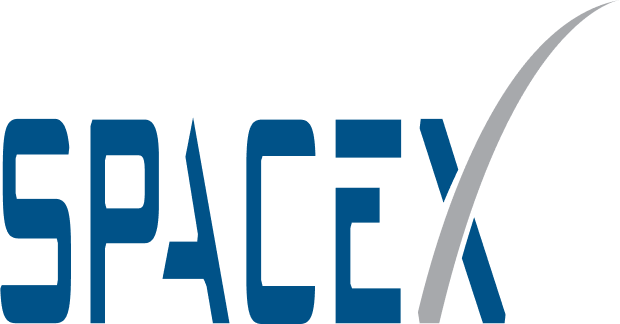Market Size of satellite communications Industry

|
|
Study Period | 2017 - 2029 |
|
|
Market Size (2024) | USD 193.30 Billion |
|
|
Market Size (2029) | USD 297.25 Billion |
|
|
Largest Share by Orbit Class | LEO |
|
|
CAGR (2024 - 2029) | 8.99 % |
|
|
Largest Share by Region | North America |
Major Players |
||

|
||
|
*Disclaimer: Major Players sorted in no particular order |
Satellite Communications Market Analysis
The Satellite Communications Market size is estimated at USD 193.30 billion in 2024, and is expected to reach USD 297.25 billion by 2029, growing at a CAGR of 8.99% during the forecast period (2024-2029).
193.30 Billion
Market Size in 2024 (USD)
297.25 Billion
Market Size in 2029 (USD)
15.35 %
CAGR (2017-2023)
8.99 %
CAGR (2024-2029)
Largest Market by Satellite Mass
80.32 %
value share, 100-500kg, 2022
Minisatellites with expanded capacity for enterprise data (retail and banking), oil, gas, and mining, and governments in developed countries pose high demand. The demand for minisatellites with a LEO is increasing due to their expanded capacity.
Fastest-Growing Market by Orbit class
13.91 %
Projected CAGR, GEO, 2023-2029
The increasing demand from governments for military applications is one of the major factors driving the demand for GEO satellites.
Largest Market by Orbit Class
85.79 %
value share, LEO, 2022
LEO satellites are increasingly being adopted in modern communication technologies. These satellites serve an important role in Earth observation applications.
Largest Market by region
77.67 %
value share, North America, 2022
The increasing investment in satellite equipment to enhance the defense and surveillance capabilities, critical infrastructure, and law enforcement agencies using satellite systems are expected to drive the LEO satellite market in the North American region.
Leading Market Player
74.82 %
market share, Space Exploration Technologies Corp., 2022

SpaceX is the leading player in the global satellite communication market. The company maintains its market share globally through its Starlink project in over 53 countries, and it produces 120 satellites per month.
LEO satellites are expected to comprise the leading segment
- A satellite or spacecraft is usually placed into one of many special orbits around the Earth, or it can be launched into an interplanetary journey. There are three types of Earth orbits: geostationary orbit (GEO), medium Earth orbit (MEO), and low Earth orbit (LEO). Many weather and communications satellites tend to have high Earth orbits, which are farthest from the surface. Satellites in medium Earth orbit include navigational and specialized satellites designed to monitor a specific area. Most science satellites, including NASA's Earth Observation System, are in low Earth orbit.
- The rapid development of small satellites and their deployment in low Earth orbit because of their added advantages are driving the growth of the LEO segment. During 2017-2019, the majority share of the market was occupied by GEO satellites. In 2020, LEO satellites gained momentum, and they are expected to continue their growth trajectory during the forecast period as well. The LEO segment is expected to occupy a market share of 79.5% in 2029, followed by GEO, with a share of 18%.
- The different satellites manufactured and launched have different applications. During 2017-2022, of the 57 satellites launched in MEO, eight were built for communication purposes. Similarly, of the 147 satellites in GEO, 105 were deployed for communication purposes. Around 4,131 LEO satellites manufactured and launched were owned by various organizations across the world. Of that, nearly 2,976 satellites were designed for communication purposes.
Rising demand for communication application is driving the demand in the market globally
- The satellite communications market is a global industry that provides critical infrastructure for various sectors, including telecommunications, military and defence, and broadcasting. Regarding satellite launches, during 2017-2022, approximately 80% of the communication satellites were manufactured and launched by North America, followed by Europe with 15%, China with 3%, and the rest with 2%, respectively.
- North America has a strong military and defence sector that invests heavily in satellite technology, and the commercial sector is also significant, with companies like SpaceX, MDA, HughesNet, and Telesat operating large fleets of satellites for broadband internet, TV broadcasting, and other services.
- Europe is another significant player in the global satellite communications market, and it is home to several leading satellite manufacturers, including Thales Alenia Space and Airbus Defence and Space. The European Space Agency (ESA) invests heavily in space technology to support national security and defence initiatives. The commercial satellite communications market is also significant, with companies like Eutelsat and SES operating large fleets of satellites for communication, broadcasting, and other services.
- The Asia-Pacific region is expected to be the fastest-growing market for satellite communications, driven by increasing demand for high-speed data transmission and rising investments in satellite technology. China and India are two of the largest markets in the region, with both countries investing heavily in space technology to support national security and defence initiatives and drive economic growth.
Satellite Communications Industry Segmentation
10-100kg, 100-500kg, 500-1000kg, Below 10 Kg, above 1000kg are covered as segments by Satellite Mass. GEO, LEO, MEO are covered as segments by Orbit Class. Broadcasting, Mobile Communication, Satellite Phone, Others are covered as segments by Communication Type. Commercial, Military & Government are covered as segments by End User. Asia-Pacific, Europe, North America are covered as segments by Region.
- A satellite or spacecraft is usually placed into one of many special orbits around the Earth, or it can be launched into an interplanetary journey. There are three types of Earth orbits: geostationary orbit (GEO), medium Earth orbit (MEO), and low Earth orbit (LEO). Many weather and communications satellites tend to have high Earth orbits, which are farthest from the surface. Satellites in medium Earth orbit include navigational and specialized satellites designed to monitor a specific area. Most science satellites, including NASA's Earth Observation System, are in low Earth orbit.
- The rapid development of small satellites and their deployment in low Earth orbit because of their added advantages are driving the growth of the LEO segment. During 2017-2019, the majority share of the market was occupied by GEO satellites. In 2020, LEO satellites gained momentum, and they are expected to continue their growth trajectory during the forecast period as well. The LEO segment is expected to occupy a market share of 79.5% in 2029, followed by GEO, with a share of 18%.
- The different satellites manufactured and launched have different applications. During 2017-2022, of the 57 satellites launched in MEO, eight were built for communication purposes. Similarly, of the 147 satellites in GEO, 105 were deployed for communication purposes. Around 4,131 LEO satellites manufactured and launched were owned by various organizations across the world. Of that, nearly 2,976 satellites were designed for communication purposes.
| Satellite Mass | |
| 10-100kg | |
| 100-500kg | |
| 500-1000kg | |
| Below 10 Kg | |
| above 1000kg |
| Orbit Class | |
| GEO | |
| LEO | |
| MEO |
| Communication Type | |
| Broadcasting | |
| Mobile Communication | |
| Satellite Phone | |
| Others |
| End User | |
| Commercial | |
| Military & Government | |
| Other |
| Region | |
| Asia-Pacific | |
| Europe | |
| North America | |
| Rest of World |
Satellite Communications Market Size Summary
The satellite communications market is a dynamic and rapidly evolving industry that plays a crucial role in supporting various sectors such as telecommunications, military and defense, and broadcasting. The market is characterized by the deployment of satellites in different orbits, including geostationary, medium, and low Earth orbits, each serving distinct purposes. The growth of small satellites, particularly in low Earth orbit, is a significant trend driving the market, as these satellites offer cost-effective solutions for communication needs. North America leads in satellite launches, with a strong presence of companies and government agencies investing in advanced satellite technologies. Europe also plays a vital role, with leading manufacturers and significant investments from the European Space Agency. The Asia-Pacific region is emerging as the fastest-growing market, driven by substantial investments in satellite technology by countries like China and India.
The market is fairly consolidated, with a few major players dominating the landscape. Companies such as Airbus SE, China Aerospace Science and Technology Corporation, Maxar Technologies Inc., Space Exploration Technologies Corp., and Thales are key contributors to the market's growth. Recent developments include strategic agreements and partnerships aimed at enhancing satellite communication capabilities and expanding service offerings. Government expenditure on space programs is substantial, particularly in North America, where significant funding supports innovation and research. The market's growth trajectory is supported by ongoing advancements in satellite technology and increasing demand for high-speed data transmission across the globe.
Satellite Communications Market Size - Table of Contents
-
1. MARKET SEGMENTATION (includes market size in Value in USD, Forecasts up to 2029 and analysis of growth prospects)
-
1.1 Satellite Mass
-
1.1.1 10-100kg
-
1.1.2 100-500kg
-
1.1.3 500-1000kg
-
1.1.4 Below 10 Kg
-
1.1.5 above 1000kg
-
-
1.2 Orbit Class
-
1.2.1 GEO
-
1.2.2 LEO
-
1.2.3 MEO
-
-
1.3 Communication Type
-
1.3.1 Broadcasting
-
1.3.2 Mobile Communication
-
1.3.3 Satellite Phone
-
1.3.4 Others
-
-
1.4 End User
-
1.4.1 Commercial
-
1.4.2 Military & Government
-
1.4.3 Other
-
-
1.5 Region
-
1.5.1 Asia-Pacific
-
1.5.2 Europe
-
1.5.3 North America
-
1.5.4 Rest of World
-
-
Satellite Communications Market Size FAQs
How big is the Satellite Communications Market?
The Satellite Communications Market size is expected to reach USD 193.30 billion in 2024 and grow at a CAGR of 8.99% to reach USD 297.25 billion by 2029.
What is the current Satellite Communications Market size?
In 2024, the Satellite Communications Market size is expected to reach USD 193.30 billion.

